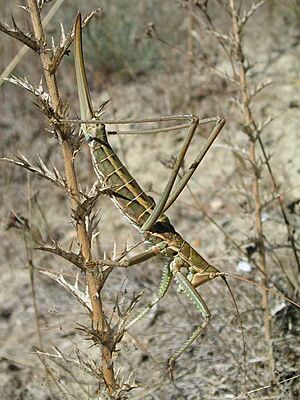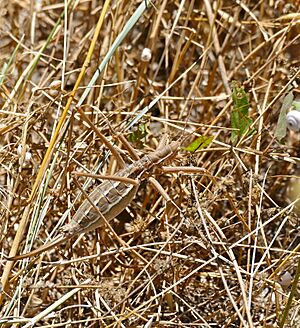Saga pedo facts for kids
Quick facts for kids Saga pedo |
|
|---|---|
 |
|
| Brown female in France | |
| Conservation status | |
| Scientific classification | |
| Genus: |
Saga
|
| Species: |
pedo
|
The Saga pedo is a very large, wingless bush cricket. You can find it in southern Europe and across western and central Asia. This amazing insect can be brown or green. From its head to the tip of its egg-laying part (called an ovipositor), it can grow up to 10.5 cm (4.1 in) long. Some even reach 12 cm (4.7 in)! This makes it one of the biggest insects in Europe and one of the largest Orthoptera (like grasshoppers and crickets) in the world. Its body alone is usually 5–7 cm (2.0–2.8 in) long, but can be up to 7.8 cm (3.1 in).
People often call it the predatory bush cricket or the spiked magician. It gets the "magician" name because of how it moves its front legs when hunting. What makes it special? It only eats meat (it's carnivorous), and it reproduces all by itself! Only females exist, and they lay eggs without a male.
Contents
How the Predatory Bush Cricket Eats
The Saga pedo is a skilled hunter. It mainly eats other Orthoptera, like grasshoppers and crickets. It also often preys on mantises, especially the European mantis. Sometimes, it will eat other insects and, very rarely, even small lizards. Young Saga pedo, called nymphs, are also hunters, just like the adults. There's even one report of a nymph drinking nectar!
This bush cricket is very sneaky and good at camouflage. It can be brown or green, with a light stripe along its side. It catches prey much like a mantis does. It has strong front and middle legs with sharp spines. When hunting, it walks slowly, often swaying to look like plants moving in the wind. It tries to surprise its prey. Once close enough, it suddenly jumps and grabs the prey with its spiny legs. Adult Saga pedo are most active at dusk and early night, but they do some hunting during the day too. Nymphs, however, are usually active during the day.
Life Cycle and Reproduction
A few weeks after growing into an adult, the female Saga pedo starts laying eggs. She will keep laying eggs for the rest of her adult life, which can be up to six months. The female has a pointed ovipositor, which is about 3–4 cm (1.2–1.6 in) long. This is a bit more than half her body length. She uses it to push her eggs into the soil in a good spot.
The eggs of the Saga pedo are among the largest known for an insect. They can be up to 12 mm (0.47 in) long and 4 mm (0.16 in) wide. A female will lay between 25 and 80 eggs. How fast the eggs develop depends on the temperature. If it's 20 °C (68 °F) or warmer, the eggs start growing right away. The nymphs hatch after about 40 to 85 days, depending on the temperature. In colder conditions, the eggs go into a resting state called diapause. This means they can stay buried for up to five years, though usually two to three years.
After hatching, which never happens before April, the nymphs grow through five to seven stages, called instars. After these stages, they become sexually mature adults. When they are very young nymphs, their ovipositor is tiny and hard to see. But in older nymphs, it becomes quite long and easy to spot.
Reproduction Without a Mate
The Saga pedo is very unusual because it reproduces asexually through parthenogenesis. This means the female lays eggs that have not been fertilized by a male. These eggs then develop into young females that are exact copies of their mother! Because of this, it seems that only females exist in this species. There has never been a confirmed sighting of a male Saga pedo. There are a couple of old stories about males, but they don't have proof and are not believed. A recent photo from Switzerland in 2005 seemed to show a male, but it might have just been a female that looked like a male.
In labs, a female S. pedo was able to have babies with a male from a different species, S. rammei. These babies were hybrids, meaning they had traits from both parents. S. pedo has 68 chromosomes, which is a lot! Most other Saga species reproduce normally with males and females, and they have less than half as many chromosomes. Among grasshoppers and crickets, only S. pedo and a few others are known to reproduce only through parthenogenesis.
Where the Predatory Bush Cricket Lives
The Saga pedo can be found in the southern part of Europe. Its range stretches across western and central Asia, going as far east as northwestern China and southwestern Siberia. In Asia, you can find it in southern Turkey, Armenia, Azerbaijan, Tajikistan, and Turkmenistan. It goes north into Russia, up to about 54 degrees north latitude. In Europe, it lives in Italy (including Sardinia and Sicily), northern Greece, and parts of Spain. Its presence in Portugal is not certain.
In Europe, outside of Russia, it lives as far north as the Czech Republic, Slovakia, and Ukraine. Further west, it doesn't go north of the Alps (it's in Austria and Switzerland, but not Germany). In France, it's only found in southern areas, about 200 km (120 mi) from the Mediterranean Sea.
This makes Saga pedo the Saga species with the widest distribution. It reaches further north, west, and east than any other Saga species. Other Saga species are only found in the southern and eastern Balkans, Greek islands, and Southwest Asia.
S. pedo likes places with dry summers and mild winters. It can live in many different habitats, from sea level up to 1,750 m (5,740 ft) high. You might find it in grasslands, meadows, pastures, areas with shrubs, thickets, plains, forest steppes, open areas near forests, gorges, hedges, grain fields, and even vineyards.
Accidental Visit to North America
The Saga pedo was accidentally brought from Europe to Michigan, USA, in 1970. Only six of these insects were found between 1970 and 1972. No reliable source has found any since, so it's thought they are no longer in North America. There have been a few unconfirmed sightings later on. A high school teacher reported catching several in Michigan from 2004 onwards, but this still needs to be officially confirmed by scientists.
Protecting the Predatory Bush Cricket
The Saga pedo lives in a huge area, but there aren't many of them in each place. Their numbers are threatened by the use of insecticides and the loss of their habitat. When scientists last checked the species globally in 1996, it was considered vulnerable. However, when only the European population was checked in 2016, it was listed as least concern, meaning it's not currently at high risk there.
S. pedo is protected by the Berne Convention (Appendix II) and the European Union's Habitats Directive (Annex IV). This means it is strictly protected in these regions. Natural enemies of adult Saga pedo include birds, rodents, lizards, frogs, and toads. Younger nymphs can be eaten by spiders, scorpions, centipedes, and other predatory insects.







